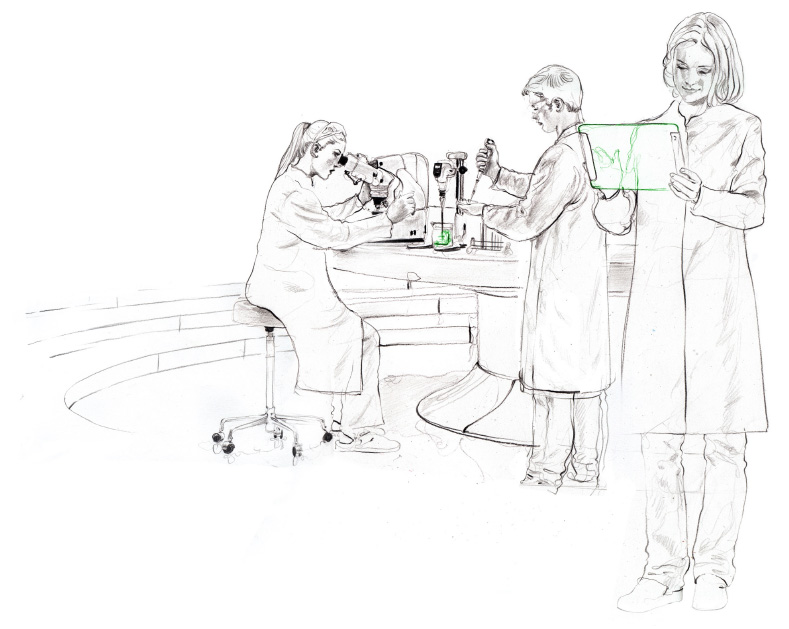Recombinant DNA (rDNA) is genetic material that has been modified with laboratory processes. Since its discovery, recombinant DNA technology has revolutionized many fields in life sciences, as well as in medical research.
In this article, we will provide you with a brief insight of what determines recombinant DNA as well as historical background information and fascinating facts about the numerous fields of application, including the production of recombinant antibodies.
The term “recombinant DNA” refers to the result of a recombination of DNA molecules from different sources with laboratory processes, creating a new combination of genetic material. This process is commonly used in genetic engineering and biotechnology to create genetically modified organisms (GMOs) with specific traits or characteristics.
Recombinant DNA has revolutionized many fields, including medicine, agriculture, and industry. It has allowed scientists to create new medicines, develop crops that are resistant to pests and diseases, and produce enzymes and other proteins for industrial use.
Subscribe to our Newsletter
Get all the latest updates, and learn about our advancements in antibody production.
Subscribe now
An important decade in the history of rDNA are the 1970s: Recombinant DNA technology, also known as genetic engineering, emerged in the early 1970s as a powerful tool for manipulating genetic material. The development of this technology was made possible by the discovery of restriction enzymes, which are capable of cutting DNA at specific locations.
In 1972, the first recombinant DNA molecule was created by combining DNA from two different sources. This breakthrough was followed by the development of techniques to produce large quantities of recombinant proteins for medical and industrial use.
Recombinant DNA has revolutionized modern biology, enabling scientists to study and manipulate genes with unprecedented precision. It has also led to the development of new drugs, genetically modified organisms, and improved diagnostic tools for genetic diseases. For instance, the history of antibodies is intensely linked to the development of recombinant DNA.
There are several methods in the production of rDNA today, depending on the specific needs of the experiment or application. Here are some of the most common methods to produce recombinant DNA:
Each of these methods has its advantages and limitations, and researchers must choose the most appropriate method for their specific experiment or application.

Recombinant DNA technology has revolutionized the field of biotechnology and has had a significant impact on various aspects of life. It has allowed scientists to manipulate the DNA of organisms by cutting and pasting genetic material from different sources, creating novel organisms with desired traits.
This technology has also led to the production of life-saving drugs, such as insulin and growth hormones, and has been used in the development of genetically modified crops that can resist pests, tolerate extreme weather conditions, and provide higher yields. It has also enabled the study of gene function, leading to a better understanding of diseases and the development of targeted therapies.
Recombinant DNA technology has contributed to the advancement of fields such as agriculture, medicine, and bioremediation. It has provided tools for genetic modification and the production of novel proteins, enzymes, and recombinant antibodies, opening up new avenues for research and development. Overall, recombinant DNA technology has significantly impacted science, medicine, and the global economy.
rDNA is used for numerous applications in various fields. In medicine, recombinant DNA is used to generate therapeutic proteins, such as in the production of recombinant antibodies, insulin, growth hormones, and clotting factors for patients with genetic disorders. Recombinant DNA technology has also led to the development of vaccines for diseases like hepatitis B.
In agriculture, recombinant DNA has been used to develop crops that are resistant to pests and herbicides. In environmental science, on the other hand, recombinant DNA is studied as a means to degrade toxic substances and clean up contaminated areas.
Among other fields, recombinant DNA technology has numerous applications in
Read more on: What is recombinant DNA used for?
Here are 9 examples of recombinant DNA revolutionizing the way we face challenges across various disciplines:
Recombinant DNA plays an essential role in the production of recombinant antibodies, which are engineered antibodies that can target specific molecules or cells. This technology is used to create recombinant DNA that encodes for antibodies with specific functions. The recombinant DNA is then introduced into a host organism, such as bacteria or mammalian cell culture (e. g. CHO cells), which produce the recombinant antibody.
This is also why recombinant DNA is our daily bread: We rely on the technology for the production of recombinant antibodies for various purposes, providing partners worldwide with our recombinant antibody expression service.